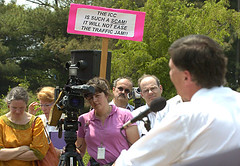Interesting difference of opinion between the Baltimore Sun and the Washington Post on the Inter County Connector
 Gov. Robert L. Ehrlich Jr. speaks at a news conference announcing Federal Highway Administration approval of the Intercounty Connector. Protesters stand in the background. (Sun photo by John Makely) May 30, 2006.
Gov. Robert L. Ehrlich Jr. speaks at a news conference announcing Federal Highway Administration approval of the Intercounty Connector. Protesters stand in the background. (Sun photo by John Makely) May 30, 2006.Yesterday, both the Post and the Sun ran editorials on this issue. The Sun editorial, "The ICC, for better or worse," is much more equivocal:
This week's hastily arranged and protester-laden press conference by Gov. Robert L. Ehrlich Jr. announcing federal approval of the Intercounty Connector was a fitting milestone for a project that's been plagued by controversy. Several generations of Montgomery County leaders have been talking about developing an east-west commuter corridor. Now, it seems to be just a matter of months before construction begins.
That's good news, right? So why does it all seem a bit anticlimactic?
Perhaps it's because the criticisms raised by protesters like those at Tuesday's announcement are not without merit. By any measure, the ICC is going to be costly. Most recent estimates peg it at $2.4 billion, making it Maryland's most expensive public works project. Its financing will require not only toll collection (of up to $1,500 per year for a daily, rush-hour commuter) but also a willingness to issue restrictive bonds that will require the state to devote a big share of Maryland's future federal highway aid toward repayment. It's been done in other states but not usually so much for a single project or for so large an amount.
Such a financing plan defers costs (and the traditional consequence - higher gas tax or highway user fees) into the future. But what does it mean for Maryland's transportation plans in the years to come? Are we committing too much of our limited resources to highway construction when we should be investing in more energy-efficient transit modes? That question was answered several years ago when Mr. Ehrlich first pledged his support for the ICC. But gas prices of $3 a gallon and more put the question in quite a different context today.
The Post's editorial is much more positive, "Green Light for the ICC," as is clear from the subtitle "At last, a vital link is approved." The Post editorial criticizes civic opposition, weak-kneed politicians for yielding to civic opposition, and concedes that the road won't have much impact on congestion--but will increase employment.
FINAL FEDERAL approval for the construction of the intercounty connector in suburban Maryland will inspire neither fist-pumping celebratory rallies nor dancing in the streets, but it is historic and important nonetheless. After half a century of to-ing and fro-ing, attended by ever-escalating cost estimates, the authorization to begin construction clears the way for a badly needed 18-mile conduit between two vital corridors in the region: Interstates 270 and 95. Whatever the connector's impact on congestion, there is little doubt that it will spur job creation and ease access to Baltimore-Washington International Thurgood Marshall Airport.
Relatively few major roads have been built recently in the Washington area, and fewer still in the Maryland suburbs, which badly need them. The connector's path to approval is a case study for understanding why. Opposed by community groups, environmentalists and anti-growthers, the link was juggled like a hot potato by one weak-kneed politician after another and given up for dead for years at a time. That it appears to have received the final go-ahead is a testament to the determination and leadership of many people, notably Gov. Robert L. Ehrlich Jr. (R) and Montgomery County Executive Douglas M. Duncan (D). Unfortunately, Mr. Duncan, who is seeking the Democratic nomination to challenge the governor this fall, could not attend the ceremony marking the federal approval because Mr. Ehrlich, in a petty move, did not notify him until a few hours in advance.
Interesting.
Index Keywords: sprawl



0 Comments:
Post a Comment
<< Home